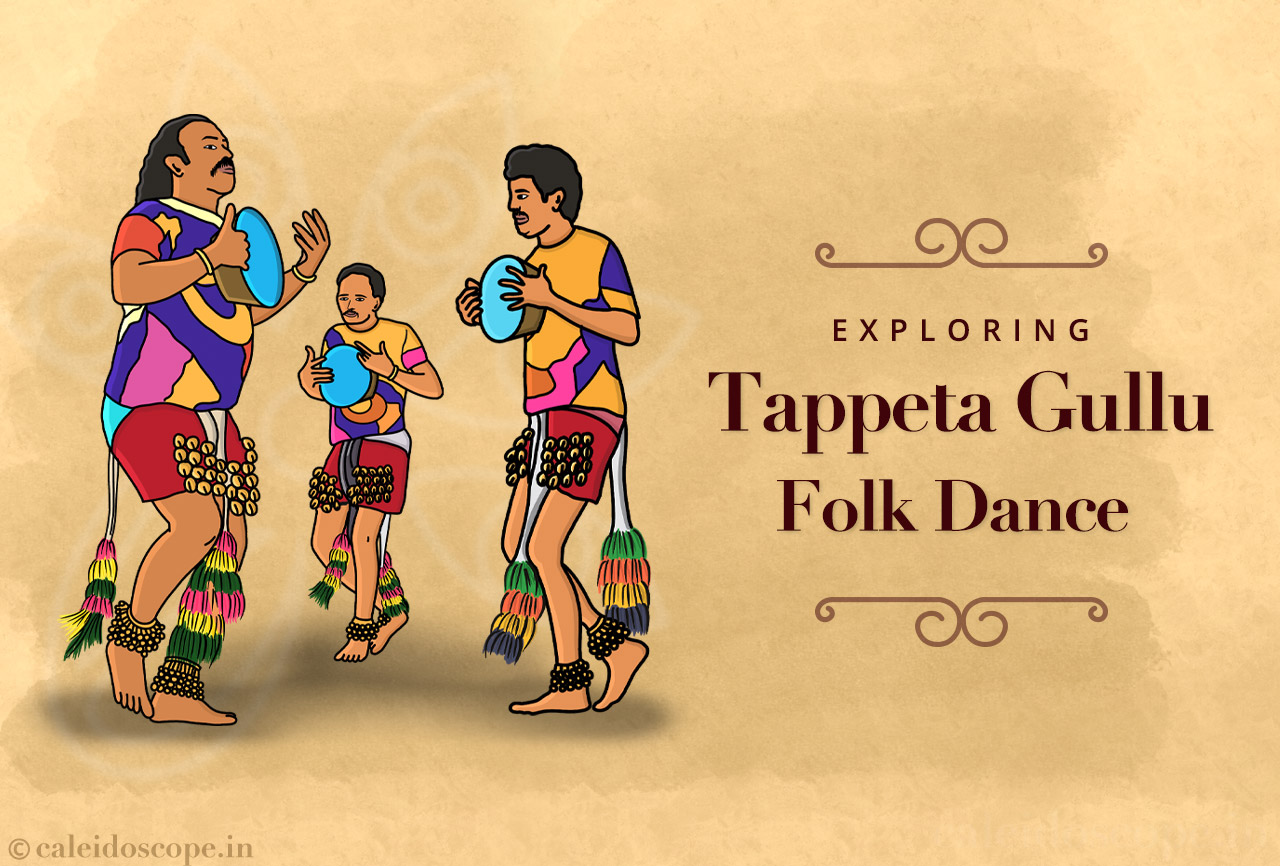
Dance can be viewed as a simple collection of body movements coupled with music. However, dance is much more than that. It is a form of storytelling. Whether it’s ballet or Kathakali or flamenco, each dance form tells a story, from mythological tales to portraying ideals man should strive for. Dance is a unique form of storytelling, engaging many of our senses to engage, amaze and evoke. Folk dance is one such variant of dance styles that includes informal dance forms amongst certain communities presenting their stories. They depict stories of the communities that perform them in simple and lively manners. The dance of Tappeta Gullu from Andhra Pradesh is one such dance style.
Origins of Tappeta Gullu
Tappeta Gullu has its origins amongst local traditions and religions. In the ancient times, cattle herds performed folk dances to appease and please Gangamma, the local Goddess for fertility. The Goddess is believed by the local people to be the sister of Lord Venkateshwara. Gangamma, according to local tradition, is said to have come to the earth to end the rule of a demon king, under whom the earth suffered drought and suffering. After the Goddess overthrew him, the sky produced rain and the people became prosperous. This is why People turn to her in hopes of healthy children, rains and plentiful crops in the Southern states of Andhra Pradesh, Telangana and Karnataka.
Etymology of Tappeta Gullu
The word ‘Tapetta’ is the name of the drum that the dancers wear on their chest while dancing. ‘Gullu’ means alarm or announcement, in a manner. Hence, Tapetta gullu means ‘drum announcement’, an announcement of the festival celebrating Gangamma.
Tappeta Gullu Performances Today
The dance is performed by the Yadavas or Golla community today during the Gangamma jatara or Gangamma fest, a festival with music, dance, fairs and feasts in the state of Andhra Pradesh and Telangana dedicated to Goddess Gangamma during the Jyeshta masam. Tapetta Gullu is at the core of the festival, being one of the oldest traditions in the festival.
Golla Community
The dance is performed by the Golla community, the Telugu community of cowherds, sheep herds and goat herds. They are a part of the Yadava clan, and claim relations to Lord Krishna, who was said to be a Yadava himself. However, the Gollas worship all Hindu Gods.
Tappeta Gullu Performance
The performance itself is almost ritualistic. Before the dance, a man holding a beautifully decorated pot of water goes around the village. This pot of water represents Gangamma, and the ritual of taking the pot around is symbolic. It means her presence blesses the entire village. Then starts the dance itself. There is either a dedicated vocalist, or the dancers themselves sing the songs sometimes. The dancers are only men, dressed in vibrant, colourful clothing, with matching loincloths and headscarves. They wear the traditional drum or the Tappeta around their neck, and beat the drums in synchronised perfection. They also wear heavy anklets around their ankles, which add to the depth of the music. However, this also means that the dancers have to be perfectly synchronised in their movements, for a delayed or premature movement would disturb the perfect beat of the anklets singing together in rhythm. The artists also perform elaborate stunts and somersaults as a part of the dance, enthralling the audience. It is said that entire villages used to gather around to witness the spectacle of Tappeta Gullu.
Themes of Tappeta Gullu
The themes in Tapetta Gullu revolve around Hindu mythology, with songs praising the greatness of Lord Vishnu, his forms, and Gangamma thalli. The themes also include episodes from the Ramayana, the Mahabharata and other Hindu texts. During the Gangamma Jatara, however, the dance mostly focuses on Goddess Gangamma and the story of her dispelling evil and dispensing prosperity on earth.
Cultural Significance of Tappeta Gullu
The significance of Tappeta Gullu is monumental. It is not just a source of entertainment, but it is also a reflection of the rich cultures and traditions of Andhra Pradesh. Everything from the costumes, the drums, the songs, the beat and the dance itself is representative of the history of the art forms of Andhra Pradesh. It also represents the enduring faith of the people in the traditional religions and traditions of the region. The dance is a scintillating performance and brings together people of all communities who witness the spectacle.
Present State of Tappeta Gullu
The present state of this dance form is not ideal. The dance form is a part of traditional folk cultures, which are on the decline these days. According to a Tappeta Gullu teacher, Appa Rao, of the Debbagudivalasa village in the Vizianagaram district of Andhra Pradesh, there is an increasing tendency to look down upon the folk cultures due to intrinsic inferiority complexes. This is why traditional forms of entertainment are declining today, and this is the same fate that is enveloping Tappeta Gullu. However, of late, there has been a resurgence in the celebration of our traditional practices, sometimes even in popular culture. Tapetta Gullu was featured in the hit Telugu film Rangasthalam, stirring renewed interest in the dance form in the Telugu states.
The artists and dancers who remain today are determined to preserve the dance form despite all challenges. The future of Tappeta Gullu is bright.
Conclusion
Tapetta Gullu is a vibrant folk dance form that represents the culture and traditions of not just Andhra Pradesh, but also India. It is important that we take pride in the vibrant traditional practices of our country to truly retain the essence of India.





